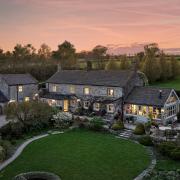Hidden gems are beginning to emerge as Cannon Hall ploughs on with its garden restoration.

While gardeners put the finishing touches to a wildflower meadow by the newly restored lakes at Cannon Hall, history enthusiasts are digging around inside for clues.
As part of the Barnsley attraction’s £3million programme to restore its 70 acres of park and gardens to their former Georgian glory, it called in a horticultural expert to carry out a plant survey. The results were surprising to say the least.
‘One of the exciting aspects of the project that people maybe don’t know about is the research we’re doing behind the scenes,’ said Sharon Sutton, project manager for the Cannon Hall: Restoring the Glory, Revealing the Secrets programme. ‘Most of the staff already knew we had a number of significant plants in our collection, but even they didn’t know quite how significant.
‘The expert we called in is fairly certain that we have an ash tree, magnolia and rhododendron that were the first ever introduced to this country. He’s taken measurements and, in his opinion, they are older than the ones previously believed to be the first.
‘The family here kept every scrap of paper which, in some respects, is great because we know the confirmation is somewhere in the archives amongst all the diary entries and invoices. But it also means there’s an absolute mountain of paperwork to get through. Once we have that double confirmation though – the expert’s opinion and the paperwork to back it up – we’ll be crowing from the rooftops.’
In the meantime, there’s still a lot to brag about at Cannon Hall, which was owned by the Spencer-Stanhope family for 300 years, reopening as a museum in 1957. A year into its two-year garden restoration scheme, the lakes have already been given a complete makeover, revealing new vistas and making each visible and accessible for the first time in decades. Once the whole scheme is completed, visitors will be able to hire rowing boats and fishing equipment, emulating popular Georgian pastimes.
‘That’s about a quarter of the whole project ticked off,’ said Sharon. ‘Visitors are already enjoying the benefits. They can get down to the lakes now and see them clearly because the vista has been altered to make them more accessible.
‘Next up is a new pathway from the car park right around the parkland, so everyone will be able to access the entire grounds safely. I think people will be surprised at how much more there is to see. Even visitors who know the park well have only ever seen about two-thirds of what’s actually here. By the end of the project, they’ll be able to see everything this wonderful park has to offer.’
The restoration programme, funded by the Heritage Lottery Fund, Big Lottery Fund’s Parks for People programme and the Friends of Cannon Hall, also includes a host of original features, some of which have never been seen by the public before.
Among the hidden gems being brought to the fore are an ice house built in the 1700s and a two-acre area of woodland behind the existing walled garden that will be opened up for educational tours and activities.
An adventure trail is being created through the woods from the deer shelter to the museum; a gardener’s cottage is being restored to create a base for volunteer activities; and a ‘midden’ (an outside toilet for those of you who don’t remember the good old days) will be revealed in all its, erm, glory.
After two years of planning, research and consultation involving more than 100 people, work began on the Restoring the Glory project in 2018. It should be finished by the end of May next year.
A summer of celebratory events are in the pipeline for August 2020, including exhibitions, a digital photography competition, before, during and after drone footage, and an open day with stalls, activities and installations, including – fingers crossed – a few borrowed pieces from Yorkshire Sculpture Park down the road.
The house and garden currently attract between 320,000 and 350,000 visitors a year and it’s hoped that the renovation work will bring in a further 100,000 people. But that’s not the only measure of success for this scheme.
‘The number of people joining our gang of volunteers is also crucial,’ said Sharon. ‘We’ve already more than doubled our number of sign-ups since the project began but we’d love more people to come on board. They’re key to the legacy of this project.’
The volunteering ethos at Cannon Hall revolves around friendship, healthy living, mindfulness and learning. It invests in its volunteers, helping them to develop their own skills in whatever area they are interested in, be it horticulture, business management, history or retail.
It already has a wide range of volunteers, including people recovering from illness, college students looking for practical work experience and people with learning difficulties looking for structure and training.
‘We try to make it welcoming and worthwhile for everyone,’ said Sharon. ‘Personally, I absolutely love it here. I bounce up from the car park every morning. And if I won the lottery, I’d still be here every day.
‘It’ll be a bitter-sweet moment when it’s all done and I have to move on to my next project, but I know that, down the line, I’ll be able visit and have a quiet little smile to myself knowing that I’ve been part of something amazing.’



























